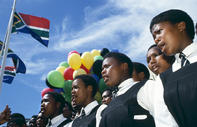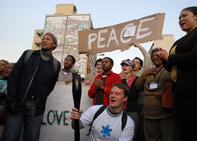On April 20th 1994, the (then) State President, FW De Klerk, proclaimed that the Republic of South Africa would have two national anthems. Namely, Nkosi Sikelel’ iAfrika (God bless Africa) and Die Stem van Suid-Afrika (The call of South Africa).

This was part of the provisions of the interim constitution of 1993, Section 248 (1) and Section 2. In terms of Section 4 of the new Constitution of South Africa, which was signed into law at Sharpeville on December 10th 1996, a shortened and combined version of Nkosi Sikelel’ iAfrica with Die Stem van Suid Afrika is now the national anthem of South Africa. As proclaimed in the Government Gazette No. 18341, dated on October 10th 1997.
Die Stem van Suid Afrika
Die Stem van Suid-Afrika (The Call of South Africa) was written by CJ Langenhoven in May 1918, as a poem. Reverend ML de Villiers, composed the music in 1921. At the close of each broadcast, the South African Broadcasting Corporation (SABC) used to play both God save the King and Die Stem.
The first public singing of Die Stem with the official raising of the national flag was on 31 May 1928, in Cape Town. However, it was only in 1957 on May 2nd, that the government announced that Die Stem was the official national anthem, which was also the year that they obtained the copyright. In 1959, the official national anthem was confirmed by an Act of Parliament.
The English version of the national anthem, The Call of South Africa, became the anthem in 1952, when it was accepted for official use.
Nkosi Sikelel' iAfrika
Enoch Sontonga, a Methodist mission school teacher, composed the first stanza of Nkosi Sikelel' iAfrika as a Xhosa hymn in 1897. Later seven other stanzas were added in Xhosa and were written by poet Samuel Mqhayi. A Sesotho version of Nkosi Sikelel' iAfrika, which was published in 1942, was written by Moses Mphahlele.
Nkosi Sikelel' iAfrika became a popular hymn, after being sung at concerts in Johannesburg lead by Reverend JL Dube's Ohlange Zulu Choir. Later it became the anthem that was sung at political meetings, as an act of defiance, during the apartheid years.
Generally, the first stanza is sung in Xhosa or Zulu and then the Sesotho version. However, Nkosi Sikelel' iAfrika has no standard version or translation and the words differ from place to place and from occasion to occasion.
The Official Words
This is the official version of the national anthem, combining Nkosi Sikelel' iAfrika and Die Stem/The Call of South Africa, with a translation in English given in brackets:
isiXhosa and isiZulu
Nkosi Sikelel' iAfrika
(God Bless Africa)
Maluphakanyisw' uphondo lwayo,
(Raise high Her glory)
Yizwa imithandazo yethu,
(Hear our Prayers)
Nkosi sikelela, thina lusapho lwayo
(God bless us, we her children)
Sesotho
Morena boloka setjhaba sa heso,
(God protect our nation)
O fedise dintwa le matshwenyeho,
(End all wars and tribulations)
O se boloke, O se boloke setjhaba sa heso,
(Protect us, protect our nation)
Setjhaba sa South Afrika - South Afrika.
(Our nation South Africa - South Africa)
Afrikaans
Uit die blou van onse hemel,
(Ringing out from our blue heavens)
Uit die diepte van ons see,
(From the depth of our seas)
Oor ons ewige gebergtes,
(Over our everlasting mountains)
Waar die kranse antwoord gee,
(Where the echoing crags resound)
English
Sounds the call to come together,
And united we shall stand,
Let us live and strive for freedom,
In South Africa our land.
Protocol on Respecting the National Anthem
